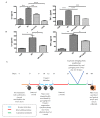Capsaicin Inhibits Inflammation and Gastric Damage during H pylori Infection by Targeting NF-kB-miRNA Axis
- PMID: 35745495
- PMCID: PMC9227394
- DOI: 10.3390/pathogens11060641
Capsaicin Inhibits Inflammation and Gastric Damage during H pylori Infection by Targeting NF-kB-miRNA Axis
Abstract
Helicobacter pylori (H. pylori) infection is considered as one of the strongest risk factors for gastric disorders. Infection triggers several host pathways to elicit inflammation, which further proceeds towards gastric complications. The NF-kB pathway plays a central role in the upregulation of the pro-inflammatory cytokines during infection. It also regulates the transcriptional network of several inflammatory cytokine genes. Hence, targeting NF-kB could be an important strategy to reduce pathogenesis. Moreover, treatment of H. pylori needs attention as current therapeutics lack efficacy due to antibiotic resistance, highlighting the need for alternative therapeutic approaches. In this study, we investigated the effects of capsaicin, a known NF-kB inhibitor in reducing inflammation and gastric complications during H. pylori infection. We observed that capsaicin reduced NF-kB activation and upregulation of cytokine genes in an in vivo mice model. Moreover, it affected NF-kB-miRNA interplay to repress inflammation and gastric damages. Capsaicin reduced the expression level of mir21 and mir223 along with the pro-inflammatory cytokines. The repression of miRNA further affected downstream targets such as e-cadherin and Akt. Our data represent the first evidence that treatment with capsaicin inhibits inflammation and induces antimicrobial activity during H. pylori infection. This alternative approach might open a new avenue in treating H. pylori infection, thus reducing gastric problems.
Keywords: H. pylori; NF-kB; capsaicin; cytokines; inflammation; miRNA.
Conflict of interest statement
The authors declare no conflict of interest.
Figures





Similar articles
-
Anti-inflammatory effect of capsaicin in Helicobacter pylori-infected gastric epithelial cells.Helicobacter. 2007 Oct;12(5):510-7. doi: 10.1111/j.1523-5378.2007.00521.x. Helicobacter. 2007. PMID: 17760719
-
Induction and Prevention of Gastric Cancer with Combined Helicobacter Pylori and Capsaicin Administration and DFMO Treatment, Respectively.Cancers (Basel). 2020 Mar 28;12(4):816. doi: 10.3390/cancers12040816. Cancers (Basel). 2020. PMID: 32231118 Free PMC article.
-
MicroRNA Modulation of Host Immune Response and Inflammation Triggered by Helicobacter pylori.Int J Mol Sci. 2021 Jan 30;22(3):1406. doi: 10.3390/ijms22031406. Int J Mol Sci. 2021. PMID: 33573346 Free PMC article. Review.
-
Lymphotoxin β receptor signalling executes Helicobacter pylori-driven gastric inflammation in a T4SS-dependent manner.Gut. 2017 Aug;66(8):1369-1381. doi: 10.1136/gutjnl-2015-310783. Epub 2016 Apr 13. Gut. 2017. PMID: 27196595
-
How Helicobacter pylori infection controls gastric acid secretion.J Gastroenterol. 2012 Jun;47(6):609-18. doi: 10.1007/s00535-012-0592-1. Epub 2012 May 8. J Gastroenterol. 2012. PMID: 22565637 Review.
Cited by
-
Glycyrrhizin, an inhibitor of HMGB1 induces autolysosomal degradation function and inhibits Helicobacter pylori infection.Mol Med. 2023 Apr 10;29(1):51. doi: 10.1186/s10020-023-00641-6. Mol Med. 2023. PMID: 37038107 Free PMC article.
-
Role of homovanillic acid esters in the regulation of skin inflammatory pathways and their effect on tight junction protein expression.Front Pharmacol. 2025 Jul 21;16:1629941. doi: 10.3389/fphar.2025.1629941. eCollection 2025. Front Pharmacol. 2025. PMID: 40761393 Free PMC article.
-
Are We Ready to Recommend Capsaicin for Disorders Other Than Neuropathic Pain?Nutrients. 2023 Oct 21;15(20):4469. doi: 10.3390/nu15204469. Nutrients. 2023. PMID: 37892544 Free PMC article. Review.
-
Sodium butyrate inhibits the expression of virulence factors in Vibrio cholerae by targeting ToxT protein.mSphere. 2025 May 27;10(5):e0082424. doi: 10.1128/msphere.00824-24. Epub 2025 Apr 22. mSphere. 2025. PMID: 40261078 Free PMC article.
-
A comprehensive review of capsaicin: Biosynthesis, industrial productions, processing to applications, and clinical uses.Heliyon. 2024 Oct 24;10(21):e39721. doi: 10.1016/j.heliyon.2024.e39721. eCollection 2024 Nov 15. Heliyon. 2024. PMID: 39524861 Free PMC article. Review.
References
-
- Singh J., Kumar P., Verma K., Tiwary S.K., Narayan G., Dixit V.K. Molecular genetic changes in gastric carcinoma. Int. J. Mol. Immuno Oncol. 2021;6:30–46. doi: 10.25259/IJMIO_8_2020. - DOI
Grants and funding
LinkOut - more resources
Full Text Sources

